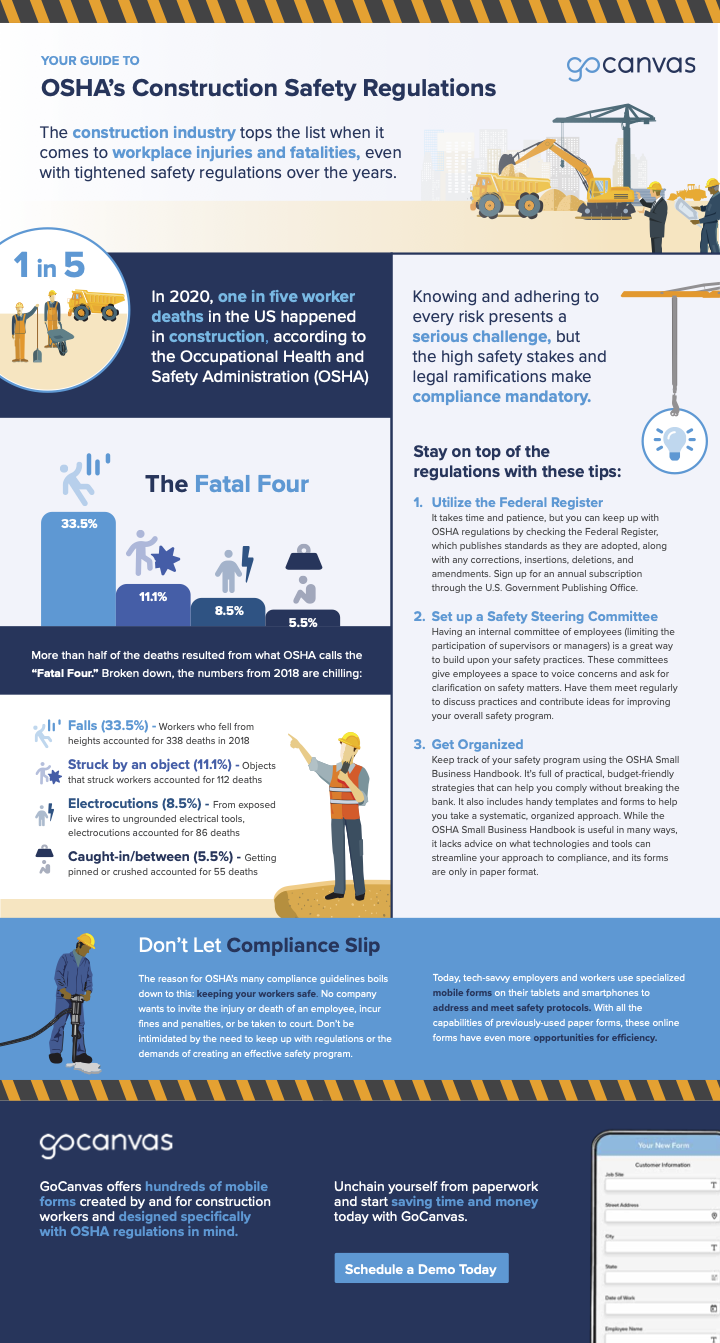Your Guide to OSHA’s Construction Safety Regulations

Check out even more resources
The Ultimate Guide to Quality Control Inspections
Discover essential steps and best practices for effective quality control inspections. Ensure accuracy, compliance, and efficiency today!
Next-Gen Project Management for Construction
In this on-demand webinar, we showcase GoCanvas’ latest product release, which is designed for construction and trade professionals.
VIP Lighting Gains Business Efficiencies with GoCanvas
See how VIP Lighting streamlined operations and improved efficiency with GoCanvas, improving data collection speed and accuracy.
Connect with an Expert Today.
We’ll help you put together the right solution for your needs.
Text Version
Your guide to OSHA’s Construction Safety Regulations.
The construction industry tops the list when it comes to workplace injuries and fatalities, even with tightened safety regulations over the years.
In 2020, one in five worker deaths in the US happened in construction, according to the Occupational Health and Safety Administration (OSHA).
The fatal four. More than half of the deaths resulted from what OSHA calls the “fatal four.” Broken down, the numbers from 2018 are chilling:
Falls (33.5%) – Workers who fell from heights accounted for 338 deaths in 2018.
Struck by an object (11.1%) – Objects that struck workers accounted for 112 deaths.
Electrocutions (8.5%) – From exposed live wires to ungrounded electrical tools, electrocutions accounted for 86 deaths.
Caught-in/between (5.5%) – Getting pinned or crushed accounted for 55 deaths.
Knowing and adhering to every risk presents a serious challenge, but the high safety stakes and legal ramifications make compliance mandatory.
Stay on top of the regulations with these tips:
- Utilize the federal register. It takes time and patience, but you can keep up with OSHA regulations by checking the Federal Register, which publishes standards as they are adopted, along with any corrections, insertions, deletions, and amendments. Sign up for an annual subscription through the U.S. Government Publishing Office.
- Set up a Safety Steering Committee. Having an internal committee of employees (limiting the participation of supervisors or managers) is a great way to build upon your safety practices. These committees give employees a space to voice concerns and ask for clarification on safety matters. Have them meet regularly to discuss practices and contribute ideas for improving your overall safety program.
- Get organized. Keep track of your safety program using the OSHA small business handbook. It’s full of practical, budget-friendly strategies that can help you comply without breaking the bank. It also includes hand templates and forms to help you take a systematic, organized approach. While the OSHA small business handbook is useful in many ways, it lacks advice on what technologies and tools can streamline your approach to compliance, and its forms are only in paper format.
Don’t let compliance slip. The reason for OSHA’s many compliance guidelines boils down to this: keeping your workers safe. No company wants to invite the injury or death of an employee, incur fines and penalties, or be taken to court. Don’t be intimidated by the need to keep up with regulations or demands of creating an effective safety program. Today, tech-savvy employers and workers use specialized mobile forms on their tablets and smartphones to address and meet safety protocols. With all the capabilities of previously-used paper forms, these online forms have even more opportunities for efficiency.
GoCanvas offers hundreds of mobile forms created by and for construction workers and designed specifically with OSHA regulations in mind. Unchain yourself from paperwork and start saving time and money today with GoCanvas. Schedule a Demo Today.